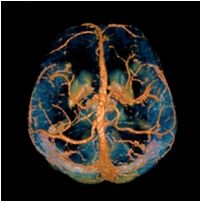Quantitative susceptibility mapping

Okay kiddo, imagine you are playing a game of treasure hunt with your friends, and you have to find the hidden treasure in a big field. But you don't know exactly where it is, so you have to use a metal detector to help you find it.
Now, in the same way, doctors and scientists use a special type of scan to find out where certain things are in your body, like iron or other minerals. They do this using a tool called quantitative susceptibility mapping (QSM).
QSM scans your body using strong magnetic fields and radio waves. These magnetic fields make tiny particles in your body (like iron) move a little bit, and the scanner can detect these movements. Then, scientists use complex math equations to figure out how much of the mineral is there and where it is located in your body.
It's kind of like drawing a map of your body but instead of finding treasure, we are trying to find special things inside your body that can help us understand your health better.
This technology is very helpful for doctors and scientists because it can help diagnose and treat certain diseases. For example, if there is too much iron in certain parts of your body, it can cause problems like heart disease. But with QSM, doctors can see exactly where the iron is and how much of it is there, so they can treat it properly.
So, in short, quantitative susceptibility mapping is a fancy way of finding things in your body by using magnetic fields and math equations. It's like a treasure hunt, but instead of treasure, we are looking for important things that can help keep you healthy.
Now, in the same way, doctors and scientists use a special type of scan to find out where certain things are in your body, like iron or other minerals. They do this using a tool called quantitative susceptibility mapping (QSM).
QSM scans your body using strong magnetic fields and radio waves. These magnetic fields make tiny particles in your body (like iron) move a little bit, and the scanner can detect these movements. Then, scientists use complex math equations to figure out how much of the mineral is there and where it is located in your body.
It's kind of like drawing a map of your body but instead of finding treasure, we are trying to find special things inside your body that can help us understand your health better.
This technology is very helpful for doctors and scientists because it can help diagnose and treat certain diseases. For example, if there is too much iron in certain parts of your body, it can cause problems like heart disease. But with QSM, doctors can see exactly where the iron is and how much of it is there, so they can treat it properly.
So, in short, quantitative susceptibility mapping is a fancy way of finding things in your body by using magnetic fields and math equations. It's like a treasure hunt, but instead of treasure, we are looking for important things that can help keep you healthy.
